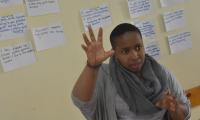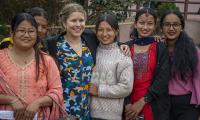Outcome Harvesting reveals: Young political leaders in Kenya become more confident
Interview with Bent Nicolajsen, Venstre, reveals how using the Outcome Harvesting method led to insights they would not have picked up on through traditional reporting methods.

A participant in the Outcome Harvesting workshop presents what her group identified as the most important outcomes in increasing involvement of young people in party politics and improving multiparty dialogue.
Bent, in 2019 you and your partner in Kenya, The Centre for Multiparty Democracy, piloted a new way of measuring results, the so-called Outcome Harvesting. Can you tell me about it?
We have partnered with Centre for Multiparty Democracy Kenya since 2011. Our focus is twofold: inclusion of youth and support to multiparty dialogue. In the outcome harvesting workshop we invited people who have been involved in the project throughout the years. More specifically, we invited young political leaders and members of the political leadership. In the workshop we basically asked them what they perceive as the most important outcomes of the different activities over the years. After the workshop we interviewed third parties about the identified outcomes, to substantiate the findings.
What surprised you the most?
Through outcome harvesting, we learned about outcomes which we would have never picked up on through our traditional reporting methods. It was incredibly inspiring that many of the youth involved in our activities mentioned that they have gained more confidence and now dare to claim their space in their political parties. This is largely due to the experience sharing they have through the multiparty platforms provided by CMD-Kenya. Another surprising outcome was how valuable the sharing of experiences across political divides is for the young politicians. They use success stories from each other to push for change within their own parties.
Outcome Harvesting is a method that enables evaluators and managers to identify, formulate, verify, and make sense of all outcomes (changes) – positive or negative, planned or unplanned – which the intervention has contributed to.
The outcome harvesting approach embraces the dynamic nature of policy work and democratic development, the fact that multiple actors often contribute towards the same outcome and that outcomes can be unpredictable and not always progressive by nature.
DIPD Outcome Harvesting Guideline (2019)
That is really interesting. What about the political leadership, do they allow for more youth to be more involved?
Great question. Another finding was that the bond between young leaders and senior political party leaders sustainably strengthened over time. This is largely due to continuous intergenerational meetings within the parties facilitated by CMD-Kenya. The interactions are also crucial in transferring leadership skills and knowledge on legislation and ideology to young party members. Youth has become a much more integrated in the political parties and political party youth leaders told that they have an increased sense of ownership towards the policies in their parties.
How will you follow up on the findings?
The findings from the outcome harvesting workshop allowed us to better plan for the upcoming year. This is because we learned about some of the barriers for more youth involvement in the political parties. One example is that even though the relationship between the youth and political leadership has improved, there is still a long way to go and more follow up meetings to the intergenerational meetings are needed.
Unlike other reporting tools, outcome harvesting can be used much more actively in planning and gives a much broader picture of the outcomes so far and the barriers and drivers for change.
Are there no bad things about outcome harvesting?
The usability of outcome harvesting very much depends on having the right participants. This means that we only had these great findings because we had put quite some work into finding the right people to participate in the workshop. Furthermore, the so-called substantiation interviews also need to be with the right people. Otherwise, the outcome harvesting method will not give a true picture of the outcome we have achieved through the project.
Before we wrap up, I want to ask if there are any important takeaways you would like to add?
Yes, there is because there were also some interesting outcomes from the People Dialogue Festival. The PDF, as we call it, is an annual democracy festival initiated by CMD-Kenya - inspired by the Danish People’s Meeting. All the people we spoke to through outcome harvesting mentioned that the annual PDF helps tear down the staircases between the people and decision makers. Just as importantly it also helps bridge cliffs between the political parties.
Contact us

Youth involvement and political dialogue in Kenya
The Danish Liberal Party work with CMD-K in stregthening multiparty democracy in Kenya.




